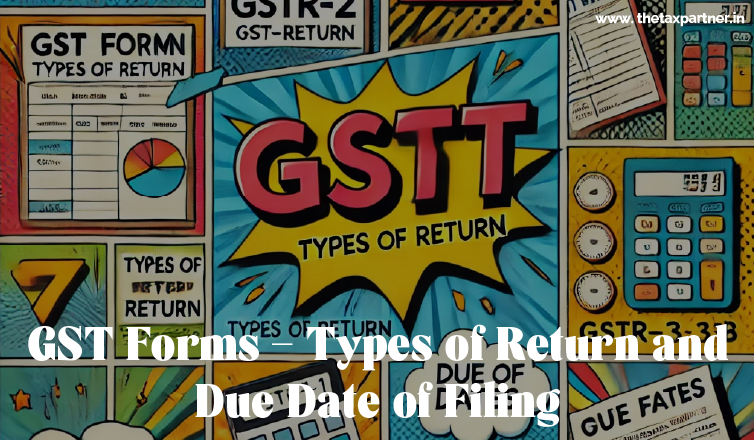Connect with us for all your queries



The Goods and Services Tax (GST) regime in India has revolutionized the way businesses operate, bringing a unified tax structure to replace the multiple indirect taxes previously levied by the central and state governments. As part of this comprehensive tax system, GST returns play a crucial role in ensuring transparency and compliance. These returns are essential documents that taxpayers must file with the tax authorities, detailing their income, expenses, and tax obligations. Understanding the various types of GST returns, their specific purposes, and the due dates for filing is vital for businesses to avoid penalties, interest, and the disallowance of input tax credits. This article provides a detailed overview of the different GST forms, their due dates, and the critical information required for filing, helping taxpayers navigate the complexities of the GST framework.
GST returns are required to be filed by taxpayers as per the law with tax administrative authorities. A normal taxpayer is required to file several monthly GST returns and one yearly return. Non-filing of these returns may lead to penalties, interest, and disallowance of an input tax credit.
Here is a summary of the different GST forms and their respective due d
|
Type of Form |
Description of the Form |
Person Liable to File |
Time Limit of Filing |
|---|---|---|---|
|
GSTR-1 |
Details of outward supplies of taxable goods and services. |
Registered Taxable Supplier |
11th of the next month (previously 10th) |
|
GSTR-2 |
Details of inward supplies of taxable goods and services claiming input tax credit. |
Registered Taxable Recipient |
15th of the next month (suspended since September 2017) |
|
GSTR-3 |
Monthly return on the basis of finalization of details of outward supplies and inward supplies along with the payment of the amount of tax. |
Registered Taxable Person |
20th of the next month (suspended since September 2017) |
|
GSTR-4/CMP-08 |
Return for a taxpayer registered under composition scheme. |
Composition Supplier |
18th of the month succeeding the quarter |
|
GSTR-5 |
Return for a non-resident foreign taxable person. |
Non-Resident Taxable Person |
20th of the next month |
|
GSTR-6 |
Return for input service distributor. |
Input Service Distributor |
13th of the next month |
|
GSTR-7 |
Return for authorities deducting tax at source. |
Tax Deductor |
10th of the next month |
|
GSTR-8 |
Details of supplies effected through e-commerce operator and the amount of tax collected. |
E-Commerce/Tax Collector |
10th of the next month |
|
GSTR-9 |
Annual return. |
Registered Taxable Person |
31st December of the next financial year |
|
GSTR-10 |
Final return. |
Taxable person whose registration has been surrendered or cancelled. |
Within 3 months of the date of cancellation or date of cancellation order, whichever is later |
|
GSTR-11 |
Details of inward supplies to be furnished by a person having UIN. |
Person having UIN and claiming a refund |
28th of the month following the month for which the statement is filed |
GSTR-1:
GSTIN, name of taxpayer, period for which the return is filed, gross turnover in the last financial year, taxable outward supplies, debit/credit note details, exempted/Nil Rated/Non-GST supplies, tax liability from advance receipts, tax paid.
GSTR-2 (suspended):
GSTIN, name of taxpayer, period for which the return is filed, details of inward supplies, import of goods, services received from outside India, credit received from input service distributor, input tax credit reversal, tax paid.
GSTR-3 (suspended):
GSTIN, name of taxpayer, address, period for which the return is filed, total turnover, details of outward and inward supplies, tax liability, TDS details.
GSTR-9:
Annual return, accumulation of all 12 months' GSTR-3 returns, includes tax paid during the year.
Frequency of Filing:
Normal taxpayers initially required monthly returns. Now, those with an annual aggregate turnover up to ₹1.5 crore can file either monthly or quarterly.
GSTR-4A: Contains inward supplies details from GSTR-1.
GSTR-4/CMP-08: Quarterly return with detailed information on outward supplies, tax payment, and tax already paid.
GSTR-9A: Annual return, includes details of all quarterly returns filed, due date is 31st December of the next financial year.
GSTR-5: Contains details of outward supplies, imports made, tax paid, and input tax credit availed, due by 20th of the next month or within 7 days of surrender/expiry.
Returns for Input Service Distributor:
GSTR-6A: Monthly return, filed upon the supplier's filing of GSTR-1, contains inward supplies details.
GSTR-6: Monthly filing, generated after ISD details confirmation.
GSTR-7: Monthly return, details of tax deducted during the month.
Return for E-Commerce Operator:
GSTR-8: Filed by suppliers of e-commerce goods or services, contains details of supplies made.
New GST Form: GSTR-3B
Description: Self-declaration returns to reduce taxpayers' burden, required by all registered taxpayers except those under the Composition Scheme. Separate returns for each GSTIN.
Timely and accurate filing of GST returns is fundamental for maintaining compliance under the GST regime. Each form serves a distinct purpose, from reporting outward and inward supplies to annual returns and returns for specific categories like non-resident taxpayers and input service distributors. While the GST system has simplified tax processes and increased transparency, it also demands diligent adherence to filing deadlines and accurate reporting. By understanding the requirements and due dates for each GST form, businesses can ensure smooth operations, avoid legal complications, and maximize their input tax credit benefits. Staying informed and proactive in GST return filing will contribute to the overall efficiency and effectiveness of the tax system, benefiting both the taxpayer and the economy.
1. What is a GST return?
Answer: A GST return is a document that businesses must file with the tax authorities to report their income, expenses, and tax obligations under the Goods and Services Tax (GST) regime. It includes details of outward supplies, inward supplies, and the tax paid or collected.
2. What are the different types of GST returns?
Answer: The main types of GST returns are:
GSTR-1: Details of outward supplies
GSTR-2: Details of inward supplies (suspended since September 2017)
GSTR-3: Monthly summary of outward and inward supplies (suspended since September 2017)
GSTR-4/CMP-08: For composition scheme taxpayers
GSTR-5: For non-resident taxable persons
GSTR-6: For input service distributors
GSTR-7: For tax deductors
GSTR-8: For e-commerce operators
GSTR-9: Annual return
GSTR-10: Final return for cancelled registrations
GSTR-11: For persons with UIN claiming a refund
GSTR-3B: Self-declaration return for monthly summary
3. Who needs to file GST returns?
Answer: All registered taxpayers under the GST regime need to file GST returns. This includes regular taxpayers, composition scheme taxpayers, input service distributors, and those required to deduct or collect tax at source.
4. What is the due date for GSTR-1?
Answer: The due date for filing GSTR-1 is the 11th of the following month. This form details the outward supplies of taxable goods and services made by the taxpayer.
5. What is GSTR-3B, and how is it different from GSTR-3?
Answer: GSTR-3B is a self-declaration return where taxpayers summarize their outward and inward supplies, and pay the tax due. GSTR-3 was a monthly return that combined the details of outward and inward supplies, but it has been suspended since September 2017.
6. When should a composition scheme taxpayer file GSTR-4/CMP-08?
Answer: A composition scheme taxpayer must file GSTR-4/CMP-08 quarterly, by the 18th of the month following the end of the quarter.
7. What is the purpose of GSTR-9?
Answer: GSTR-9 is an annual return that consolidates all the monthly or quarterly returns filed throughout the year. It provides a summary
8. What is the penalty for late filing of GST returns?
Answer: The penalty for late filing of GST returns is ₹50 per day of delay (₹25 CGST and ₹25 SGST) for normal taxpayers. For taxpayers with nil tax liability, the late fee is ₹20 per day of delay (₹10 CGST and ₹10 SGST). Additionally, interest at the rate of 18% per annum is charged on the outstanding tax amount.
9. Can a taxpayer amend a filed GST return?
Answer: A filed GST return cannot be amended. However, any errors or omissions in the returns can be rectified in the subsequent returns of the current financial year. The taxpayer should include the correct details in the next month’s or quarter’s return, as applicable.
10. What is the procedure to claim a refund under GST?
Answer: To claim a refund under GST, the taxpayer needs to file Form RFD-01 on the GST portal. The application should include details of the excess tax paid, input tax credit accumulation, or any other reason for the refund claim. The authorities will process the application, and if found valid, the refund will be sanctioned and credited to the taxpayer’s bank account.
Tax Partner is India’s most reliable online business service platform, dedicated to helping you in starting, growing, & flourishing your business with our wide array of expert services at a very affordable cost.